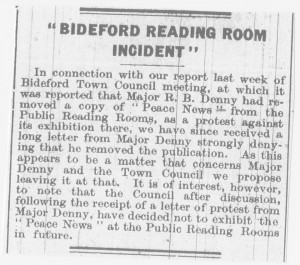Peter Christie continues his history of Bideford Bridge in World War 2
More notes from Frank Whiting’s reports.
No more war items are recorded for seven months when, in March 1943, the minutes contain the following, ‘A matter I have been rather concerned about recently, but for which I cannot see the remedy – is that when large tanks are passing over the Bridge, ordinary traffic cannot pass them, and I have even seen a motor car pull on to the pavement within one foot of the parapet, and about a week ago an unloaded lorry did the same. If a really heavy lorry did this I am not experienced enough to say if it would be safe.’
That he was right to be concerned is shown in August 1943 when he notes ‘I know there has been a tank & carrier cross the Bridge the total weight of which was 75 tons.’ Given that the current weight limit is 3 tonnes, one can only wonder how these leviathans strained the Bridge. Whiting had contacted the engineers who supervised the widening of the Bridge in 1925 for advice, and they replied that ‘the Ministry of Transport, Bridge Dep. Were rating safe loads of numerous Bridges’ and they would ask them to quickly look at Bideford.
That this was necessary is seen in the October 1943 report which notes that the kerbing on the Bridge had been damaged by ‘American Tanks’, whilst the next month there is a lengthy entry on the same subject, ‘On Wednesday Nov 3rd last a Convoy of American Tanks went over the Bridge, and appeared to be driving so carelessly that Mr.Eggins the Assistant County Road Surveyor who saw them rushed to the Police Station to see if he could get Police supervision. I happened to see the tanks myself and also Mr.Eggins.’ As a result of this Superintendent Melhuish turned up to view ‘this serious damage to Bideford Bridge.’ Rather bathetically he only suggested erecting a notice board at the end of the Bridge – presumably requesting military vehicles to drive more carefully. The Trust evidently applied for compensation, but on December 27 1943 Whiting could only admit ‘I have heard nothing further from the United States Claims Office in connection with the account I sent them in.’
Newspaper cutting from 1940 shows the extent of the feeling against the publication ‘Peace News’ in wartime.
ALSO …………..
A model gift. (From Bideford Weekly Gazette June 5th 1945).
A presentation of great historical and educational value to the town has been made to Bideford Bridge Trustees by Alderman FE Whiting FRIBA , for the past twenty years warden of Bideford’s famous Long Bridge. It consists of a 9ft 6 ins scale model of the Bridge showing the various stages of its reconstruction from circa 1280 when it was first built as a wooden bridge.
Alderman Whiting has taken six and a half years to complete the model, embodying all his knowledge gained during the past quarter of a century and all authentic records available. With photographs he has produced an accompanying illustrated guide to the model, and this is the most compact and informative history yet written and is unique in that it represents a visual, as well as literary history of the Bridge .. (Still on view in the Burton Art Gallery and Museum)


Although I was very young during ww2 your articles brought back a few memories. I remember the bomb crater on Clovelly road as we kids looked for shrapnel, the bigger the lumps the better. However I am interested in the crash of a RAF Bomber on “round hill” east of the water. I was there at the time and I think that there were no survivers. Can you help me with this topic?
Thank you
Peter